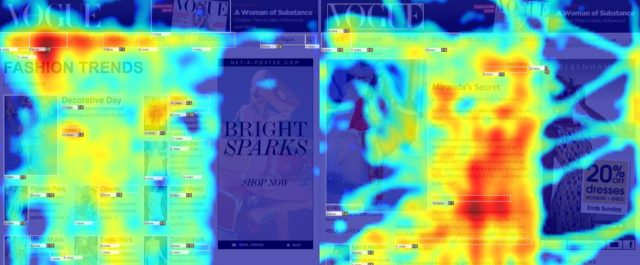All brands want to be seen, but eye tracking helps determine how effective those glances really are. The technology is being utilized by marketers and research teams to better understand human behaviors across a variety of ad types and platforms.
The Eyes Don’t Lie
A recent study by video technology platform, Teads, for example, found that users spent 24 percent more time watching video ads embedded within premium content on websites than they did watching video ads in social feeds. In addition, ad recall was twice as high for in-article video as it was for skippable pre-roll ads. Video ads embedded in premium content were found to drive purchase intent 27 percent higher than skippable pre-roll ads or video ads found on social feeds.
Another eye tracking study conducted by biometric tracking firm Sticky, ad tech firm InSkin Media and market research firm Research Now Group found that viewers need about a second of looking at an ad to have even the smallest amount of ad recall. In the study’s terminology, “gazing” means looking at an ad long enough and with enough attention to actually have the possibility of remembering it. These results aren’t terribly surprising, unless you have a photographic memory. The study determined that in order to get a second of gazing from a viewer, the ad needs to be on-screen for an average of at least 26 seconds and must be viewable for at least 14 seconds to be seen at all.
Which types of display ads are the most effective? It depends on what the consumer is looking for. Meditative conducted an eye-tracking study of 39 participants of mixed ages who were assigned certain search tasks. As they searched, participants were shown digital display ads in various sizes and positions across both web page mock-ups and actual sites.
Using the resulting data, the researchers were able to generate heat maps showing the length of time spent looking at various parts of the pages, as well as gaze maps indicating where people looked and clicked. What they found is that just because as ad is present, doesn’t mean a person will look at it.
Digital display ads were 80 percent more likely to be noticed by study participants if they were relevant to a task the searcher was currently working on, compared with ads relevant to something the searcher had looked for in the past. Out of all the ads that were served to the study participants, only 16.6 percent were actually viewed (as defined by 50 percent or more of their pixels were in view for a minimum of one second). The most-viewed ads were located above the web page compared to below—ads shown above the page were viewed 50 percent more and 87 percent longer on average.

We See What You Did There
While most studies are conducted within closed environments, technology is being tested to record eye tracking out in the world. In 2013, Google filed a patent for a system of “pay per gaze,” in which registered advertisers pay Google every time a Google Glass user looks at an ad in his/her external field of vision. The patent mentions the technology’s ability to “determine which on-screen elements draw the user eye.” The pay-per-gaze system could even track a viewer’s emotional engagement with an ad by measuring pupil dilation and retraction.
Researchers are testing a new product called SideWays that can track what products catch your attention on the shelves in physical retail stores. As soon as a customer walks up to an item, the device automatically starts tracking what he/she looks at, which could allow shop owners to cater advertisements according to interest.
Immersive Tracking
HTC has just begun rolling out VR advertisements, complete with eye tracking to measure the ads’ effectiveness. The program, still in pilot stages, is available only in China at the moment, HTC told [a]listdaily. Luckily for advertisers interested in the medium, VR has a head start on brand recall. In a recent study testing the effectiveness of marketing in VR, brand recall was at least eight times more effective across all brands with immersive VR as well as double the intent to share.
NVIDIA is studying a type of rendering based on how the human eye works. A technique called “foveated rendering” creates the highest quality imagery only at the center of your vision where your eye can detect sharp detail, while rendering low quality imagery in the periphery of your vision where your eye is not tuned to pick up high resolution details.
Combined with eye-tracking, it’s widely believed that foveated rendering is an important pathway to unlocking retinal-resolution VR rendering in the near future, meaning imagery so sharp that any additional detail would be indiscernible.
Led by medical diagnostics, the eye tracking market is estimated to exceed one million dollars by 2020, at a CAGR of 35.2 percent.
